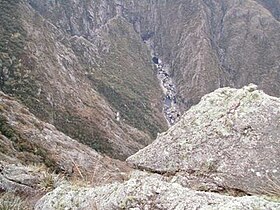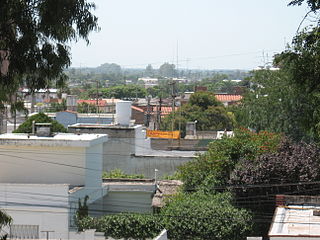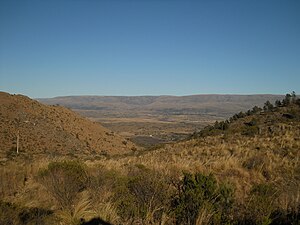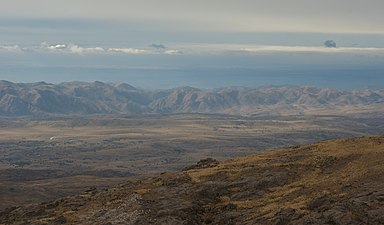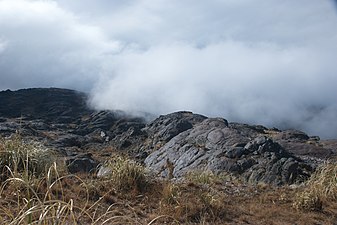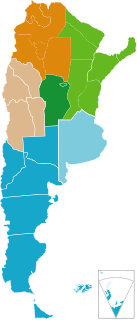
Argentina is provided with a vast territory and a huge variety of climates and microclimates ranging from tundra and polar in the south to the tropical climate in the north, through a vast expanse of temperate climate and natural wonders like the Aconcagua, the highest mountain in the world outside the Himalayas, the widest river and estuary of the planet, the huge and very mighty Iguazú Falls, some of the flattest and wide meadows-plains of planet Earth, culture, customs and gastronomies famous internationally, a higher degree of development, good quality of life and people and relatively well prepared infrastructure make this country one of the most visited of America.

The Sierras de Córdoba is a mountain range in central Argentina, located between the Pampas to the east and south, the Chaco to the north and the foothills of the Andes to the west. Almost the entire range, except for the southwestern margin in San Luis Province, is located in Córdoba Province.
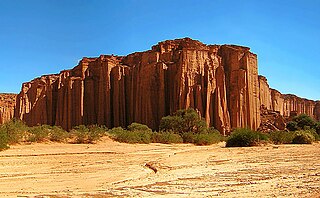
Talampaya National Park is a national park located in the east/centre of La Rioja Province, Argentina. It was designated a provincial reserve in 1975, a national park in 1997, and a UNESCO World Heritage Site in 2000.

The Calilegua National Park is a federal protected area in Jujuy Province, Argentina. Established on 19 July 1979, it houses a representative sample of the Southern Andean Yungas biodiversity in good state of conservation.
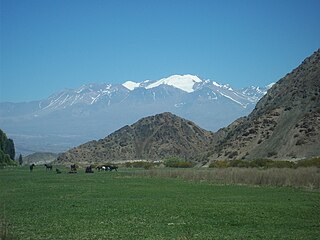
El Leoncito National Park is a federal protected area in San Juan Province, Argentina. Established on 18 September 2002, it houses a representative sample of the Central Andean Puna and the Southern Andean steppe biodiversity in good state of conservation, as well as historical and paleontological sites. It has an area of 89,706 ha

The Ichigkat Muja – Cordillera del Condor National Park is a protected area in Peru located in the region of Amazonas. It protects part of the Eastern Andes forests at the Cordillera del Condor mountain range.

Perito Moreno National Park is a national park in Argentina. It is located in the western region of Santa Cruz Province on the border with Chile. It has an area of 126,830 hectares of mountains and valleys at a height of 900 metres above sea level.

Pampa de Achala is the name given to a vast region that lies at the heart of the Sierras de Córdoba located within Sierras Pampeanas, and located in central-northwest of Argentina. It is a rugged area with little vegetation, which is over 1,500 m having distinctive species, ecology, relief and hydrography. The region is protected by provincial law, and that this region basin is head of the vast majority of streams that run through the Córdoba.

San Guillermo National Park is a national park in Argentina, in the Iglesia Department of San Juan Province. It was established in 1998 and is part of the San Guillermo Biosphere Reserve. Elevations in the biosphere range from 2,100 metres (6,900 ft) to 6,380 metres (20,930 ft). Vegetation in the National Park and biosphere consists of barren desert, grasslands, and a few wetlands, all located in the high, arid Andes. The animals include vicuña, guanaco, culpeo fox, Andean mountain cat, cougar, and Andean condor.

The Sierra de las Quijadas National Park is a national park located in the northwestern part of the Argentine province of San Luis. It was established on December 10, 1991, to protect the natural features, representative of the Semiarid Chaco and the Argentine Low Monte ecoregions.

Campos del Tuyú National Park is a national park in Buenos Aires Province, Argentina. Situated on the southern shore of Samborombón Bay, the park was established on May 13, 2009. The main attraction of Campos del Tuyú is the rare pampas deer; in fact, it is one of the few places in the Pampas where this species survive. Other inhabitants of the park include over a hundred bird species, capybara, and the likewise endangered Leopardus geoffroyi.

The Tamá National Natural Park is a national park located in the Tamá Massif of the Andean Region of Colombia, between the municipalities Toledo and Herrán, in the department of Norte de Santander, in the northeastern part of the Eastern Ranges of the Colombian Andes. One of the main attractions of the park is a 820-metre-high (2,690 ft) waterfall, one of the world's highest.
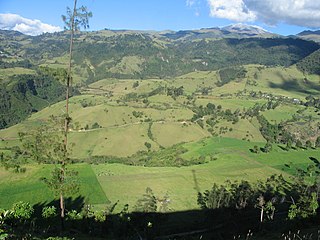
The Puracé National Natural Park is a national park located in the Andean Region of Colombia, southeast of the city of Popayán in the Cordillera Central range. Its main feature is the active stratovolcano Puracé, one of Colombia's most active volcanoes. Four of the country's most important rivers originate within the area: Magdalena River, Cauca River, Japurá River and Patía River.

Traslasierra Valley is a natural geographic region of the province of Córdoba, Argentina, located west of the Sierras Grandes and east of the Sierras Occidentales. The tourist capital is the city of Mina Clavero and the most important commercial center is the city of Villa Dolores.

Tren de las Sierras is a regional 150.8 km (93.7 mi) regional rail line in Córdoba Province of Argentina. The line runs from Alta Córdoba to Cosquín, being currently operated by state-owned company Trenes Argentinos.

The Sierra La Culata National Park Also Sierra de la Culata National Park is a national park of Venezuela that is located in the northeastern branch of the Venezuelan Andes, in the states Mérida and Trujillo. It was decreed a national park on December 7, 1989. It has a high mountain climate, with temperatures ranging between −2 and 24 °C, and its surface area is 200,400 hectares (774 sq mi).



